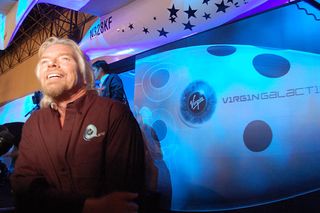Virgin Galactic's SpaceShipTwo: Tourists in for a 'Magical' Ride

The 400 space tourists who've already signed up to fly on the private Virgin Galactic space plane are in for a wild ride.
Virgin Galactic is developing the SpaceShipTwo vehicle to carry passengers to the edge of space for $200,000 each. Once the prototype is ready, a fleet of the spacecraft will be produced by The Spaceship Company, and will launch out of Spaceport America in New Mexico.
The Spaceship Company's chief engineer, Scott Ostrem, recently gave a preview of what the ride would feel like at the International Symposium for Personal and Commercial Spaceflight in Las Cruces, N.M.
Training
SpaceShipTwo passengers will arrive at the launch site three days before their flight to begin training and familiarization. [Rise of SpaceShipTwo: The Test Flights Photos]
"They're out here at Spaceport America, bonding with their fellow astronauts, being trained, going through medical checks," Ostrem told SPACE.com.
Passengers will have the option of experiencing weightlessness before their launch by flying on planes making parabolic dives to induce brief periods of zero-G. They will also have some instruction on "G-straining" muscle exercises that can help them withstand the rigors of the additional gravitational forces felt during liftoff and landing.
Get the Space.com Newsletter
Breaking space news, the latest updates on rocket launches, skywatching events and more!
Virgin Galactic has a partnership with the NASTAR training facility in Pennsylvania, where passengers will have the option of attending training courses ahead of time to ride on a centrifuge that simulates their flight profile on SpaceShipTwo.
Taking off
When it's time for the real thing, SpaceShipTwo will be attached to the underside of its mothership, WhiteKnightTwo, and the pair will take off from Spaceport America's runway. Six passengers and two pilots will be aboard SpaceShipTwo.
"I'm sure there will be a lot of anxiety, trepidation, maybe a little bit of concern: 'What did we get ourselves into?'" Ostrem said of the first-time tourists.
WhiteKnightTwo will carry the spaceship up for about an hour, to an altitude ofabout 50,000 feet (15,000 meters). There, the mothership will drop the spaceship in mid-air, and then SpaceShipTwo's rocket will lift the craft the rest of the way to space.
"For a few seconds, there's that calm before the rocket motor ignites," Ostrem said. "Then within about 7 seconds you’ve gone from a low Mach number to supersonic, and eventually you'll approach Mach 3 to 4."
The rocket motor will burn for about 60 to 90 seconds, and the vehicle will make a swift climb up to its peak altitude of 62 miles (100 kilometers) — the official boundary of space. Passengers will feel about three times the normal force of gravity on the ascent.
"I think that's kind of the magical moment that a lot of our customers are looking forward to, that serene darkness of space," Ostrem said. "We have some thrusters that can rotate the spaceship, we have windows. It's a zero-g environment, and our customers can float around, shoes off."
After 3 to 4 minutes of floating around in weightlessness, the space tourists will be instructed to get back in their seats and strap in for the trip back home.
Ostrem conceded that persuading the passengers to quit their fun could be tough.
"We're working on how we actually get everyone back in their seats, to follow directions," he said.
Coming home
The return trip will pack on even more G forces. At about 110,000 feet (33,500 meters), passengers will feel the maximum G load, about 6 times the normal force of gravity pushing into their chests. [What 6Gs Feels Like: Space Tourism Primer]
At about 90,000 feet (27,400 meters), they will go subsonic again, traveling slower than the speed of sound.
The final glide back to the ground will take from 10 to 15 minutes, Ostrem said. Then the returned passengers will be bestowed with astronaut wings.
"In the history of mankind only about 500 people have astronaut wings," Ostrem said. "Virgin Galactic aims in the first year to create almost that many astronauts."
You can follow SPACE.com assistant managing editor Clara Moskowitz on Twitter @ClaraMoskowitz. Follow SPACE.com for the latest in space science and exploration news on Twitter @Spacedotcom and on Facebook.
Join our Space Forums to keep talking space on the latest missions, night sky and more! And if you have a news tip, correction or comment, let us know at: community@space.com.

Clara Moskowitz is a science and space writer who joined the Space.com team in 2008 and served as Assistant Managing Editor from 2011 to 2013. Clara has a bachelor's degree in astronomy and physics from Wesleyan University, and a graduate certificate in science writing from the University of California, Santa Cruz. She covers everything from astronomy to human spaceflight and once aced a NASTAR suborbital spaceflight training program for space missions. Clara is currently Associate Editor of Scientific American. To see her latest project is, follow Clara on Twitter.
